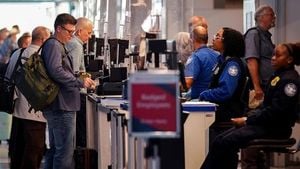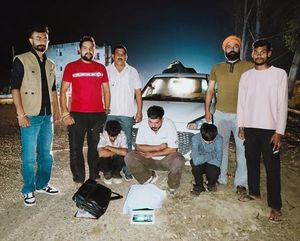As the clock struck 10 a.m. on September 9, 2025, the U.S. Congress convened its third high-profile hearing on UFOs—now officially labeled as unidentified anomalous phenomena (UAP)—since 2023. The event, hosted by the House Task Force on the Declassification of Federal Secrets, drew public attention and a sense of urgency that’s been simmering for years. With government transparency and whistleblower protection at its core, the hearing promised not just compelling testimony but also a fresh look at what the Pentagon has—and perhaps hasn’t—disclosed about these mysterious encounters.
Rep. Anna Paulina Luna, R-Florida, who chairs the newly established task force, opened the session with a clear message: “American people deserve maximum transparency from the federal government on sightings, acquisitions, and examinations of UAPs and whether they pose a potential threat to Americans’ safety.” According to USA TODAY, Luna’s committee, created in February 2025, is distinct from the subcommittee that led last November’s headline-grabbing hearing. She emphasized the need for whistleblowers to testify without fear of retaliation, a point underscored by recent reports of threats and intimidation targeting those willing to speak out.
The day’s lineup featured four witnesses: three military veterans—Jeffrey Nuccetelli, Chief Alexandro Wiggins, and Dylan Borland—and journalist George Knapp, renowned for his years of investigative reporting on UFO phenomena. Each brought first-hand accounts and a perspective shaped by years of service or scrutiny. Their testimonies were submitted in advance, with over 300 pages entered into the congressional record, as Luna confirmed in an interview with NewsNation.
Nuccetelli’s written statement, for instance, described five separate UAP incidents at Vandenberg Air Force Base—home to the National Missile Defense Project—between 2003 and 2005. “Between 2003 and 2005, five UAP incidents occurred at Vandenberg Air Force Base, home to the National Missile Defense Project, a top national security priority,” Nuccetelli stated. These incidents, he argued, highlight the potential national security implications of unexplained aerial encounters, particularly at sensitive military installations.
Chief Wiggins and Borland echoed similar concerns, recounting experiences that left them convinced something beyond routine explanations was at play. Journalist George Knapp, meanwhile, reminded lawmakers of the long-standing public fascination with the topic, fueled by decades of secrecy and the government’s shifting terminology—from UFO to UAP—in an effort to destigmatize and broaden the conversation. As BBC Future noted, “some of the witnesses say they don't believe their experiences can be understood through routine explanations.”
The hearing also revisited themes from previous sessions. Back in November 2024, four witnesses—including former military intelligence official Luis Elizondo and journalist Michael Shellenberger—testified about strange craft outmaneuvering U.S. military aircraft and flying in ways that defied known human technology. Elizondo, who ran a Pentagon UFO program for a decade, accused the intelligence community of “excessive secrecy” and claimed, “all to hide the fact that we are not alone in the cosmos.” He described an international arms race to recover and reverse-engineer these mysterious vehicles, a claim that only intensified public curiosity.
Shellenberger, for his part, testified that sources informed him the intelligence community possesses numerous high-resolution photos and videos of UAP—far superior to the grainy images released to the public so far. The notion that the government is holding back more compelling evidence has only fueled suspicions among the nearly half of Americans who, according to USA TODAY, believe officials are concealing the truth about UFOs.
In the wake of those explosive claims, the Pentagon’s All-Domain Anomaly Resolution Office (AARO) found itself under fire for its perceived lack of transparency. Yet, days after the November hearing, AARO director Jon T. Kosloski testified in the Senate, stating unequivocally, “The office has not discovered any verifiable evidence of extraterrestrial beings, activity, or technology.” This official denial has done little to quell public speculation or the determination of lawmakers like Luna to push for more answers.
Adding another layer to the intrigue, former Air Force officer and intelligence official David Grusch has alleged that the U.S. government has retrieved crashed spacecraft. In a recent interview, Grusch maintained that UFOs are real and that high-ranking officials, including the Secretary of State, have acknowledged unexplained phenomena. Luna, who met with Grusch in a secure government facility prior to the hearing, reported a “bizarre threat” related to the proceedings—raising alarms about the safety and protection of whistleblowers. “It’s very alarming, and I will leave it at that,” Luna said, underscoring the gravity of the situation.
Transparency was also on the agenda at a May 1, 2025, roundtable event on Capitol Hill, where experts in science, defense, and technology discussed the potential for UAP research to drive scientific breakthroughs and bolster national security. Hosted by the UAP Disclosure Fund and moderated by Elizondo, the session highlighted the growing appetite within Congress for open discussion and rigorous investigation.
But not all unexplained signals have turned out to be otherworldly. As BBC Future recounted, a series of strange radio bursts detected at Australia’s Parkes Observatory in 1998—initially thought to be mysterious cosmic phenomena—were eventually traced to the observatory’s microwave oven. The bursts, picked up during office hours, were caused by researchers opening the microwave before it finished, emitting radio waves that fooled even seasoned astronomers. This episode serves as a cautionary tale: not every “alien” signal comes from the stars, and sometimes the truth is closer to home than we think.
Still, the persistent reports from credible military witnesses and the apparent reluctance of some government agencies to share what they know have kept the debate alive. Lawmakers from both parties have pressed the Pentagon for more transparency, expressing frustration at what they see as efforts to evade congressional oversight. As Luna put it, “Whistleblowers who provide details on spending information and policies and procedures regarding the classification and declassification of UAPs should be able to do so without retribution.”
The hearing’s title, “Restoring Public Trust Through UAP Transparency and Whistleblower Protection,” captures the stakes. For many, the hope is that this latest round of testimony and document releases—over 300 pages, according to Luna—will move the needle toward greater openness. With more than 30 government officials, including high-ranking members of the Department of Defense, coming forward to acknowledge “something here,” the pressure is on for answers.
As the session concluded, one thing was clear: the search for truth about UAPs is far from over. While skeptics and believers continue to clash over the meaning of these encounters, Congress’s renewed commitment to transparency and whistleblower protection signals a new chapter in a saga that has captivated the public imagination for generations.




